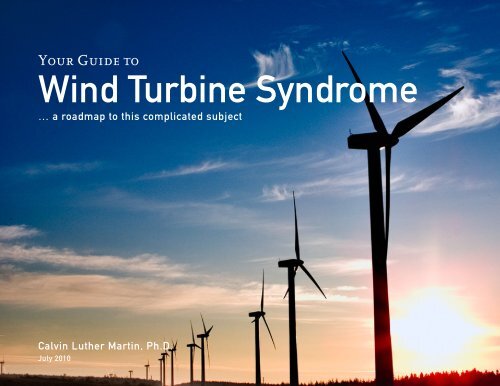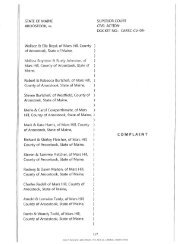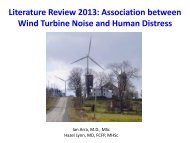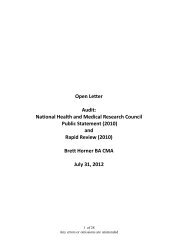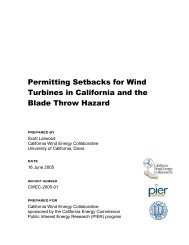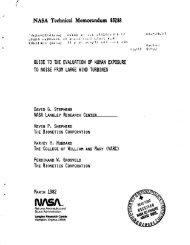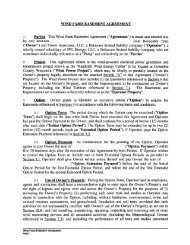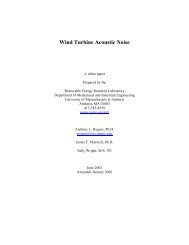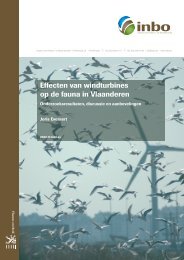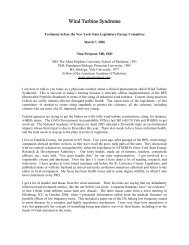Your Guide to Wind Turbine Syndrome - Wind Watch
Your Guide to Wind Turbine Syndrome - Wind Watch
Your Guide to Wind Turbine Syndrome - Wind Watch
Create successful ePaper yourself
Turn your PDF publications into a flip-book with our unique Google optimized e-Paper software.
Re-thinking <strong>Turbine</strong>sLet’s stand back for a moment. We need <strong>to</strong> re-think the notion of turbinessolely as electricity-producing machines and wake up <strong>to</strong> the fact that, for allpractical purposes, they function equally as low frequency noise-producingmachines. People often object vehemently <strong>to</strong> turbines because they considerthem ugly and outsized for their community. (Turn up your speakers andlisten <strong>to</strong> Bob Lucas’s “Green Energy Blue.”)Others object because they lower property value. (That’s true, they do hammerproperty value.)What eclipses eyesore and property value is the low frequency noise. It’s a majorhealth issue. This is more than a “nuisance.” AsNina Pierpont puts it, “People experiencingWTS are not annoyed, they are sick!”Folks who visit a wind farm and stand beneatha turbine generally have no ideathat the vestibular organs of the inner ear,along with other motion, balance, and positionsensors throughout the body, arebeing jack-hammered by a low frequencynoise they can barely hear. (The amount ofLFN produced during one’s visit depends,of course, on whether the turbines are infact generating, wind direction and windspeed, whether it’s day or nighttime, andthe degree of moisture in the air.)Butler Ridge Project near Iron Ridge, Wisconsin,May 2, 2009, with thanks <strong>to</strong> Better PlanWisconsin. (WTS.com has taken edi<strong>to</strong>rial libertieswith this pho<strong>to</strong>.)<strong>Your</strong> <strong>Guide</strong> <strong>to</strong> <strong>Wind</strong> <strong>Turbine</strong> <strong>Syndrome</strong> 5
“Calvin Luther Martin is correct [that] wind farmnoise measurements must be obtained secretly <strong>to</strong>ensure normal wind turbine operating conditions.Rick James has made it clear that wind farmopera<strong>to</strong>rs can and do reduce the noise emissionquickly if someone is spotted measuring the windfarm noise.“Over many decades of industrial noise emissionmeasurements, I have learned the best atmosphericconditions (worst case for noise impacted residents)for obtaining the highest immission noise levelis during an otherwise quiet night, when theatmosphere is stable. For wind farm noise immissionmeasurements, this means a clear night with onlya slight breeze (
“Each part of the body has its own resonancefrequency with regard <strong>to</strong> vibration. When an objectis vibrated at its resonance frequency, the vibrationis amplified. The resonant frequency of the thoracoabdominalsystem, as it moves vertically <strong>to</strong>wardsand away from the lungs, lies between 4 and 8 Hzfor adult humans. Vibrations between 4 and 6 Hzset up resonances in the trunk with amplificationup <strong>to</strong> 200%. Related chest and abdominal effects arefound in the same frequency range. Vibrations in the4-8 Hz range influence breathing movements, 5-7Hz can cause chest pains, 4-10 Hz abdominal pains,and 4-9 Hz a general feeling of discomfort. In smallchildren under 40 pounds, the vertical resonance orpower absorption peaks at 7.5 Hz, as opposed <strong>to</strong> 4-5Hz for adults.”—Pierpont, “Report for Clinicians,” ch. 2 in <strong>Wind</strong> <strong>Turbine</strong><strong>Syndrome</strong> (2009)<strong>Your</strong> <strong>Guide</strong> <strong>to</strong> <strong>Wind</strong> <strong>Turbine</strong> <strong>Syndrome</strong> 13Denmark
WTS VictimsPeople suffering from <strong>Wind</strong> <strong>Turbine</strong> <strong>Syndrome</strong> feel desperate. Oftentimesthey feel they are losing their minds. This being neither surprising nor unreasonable,given that they are losing their ability <strong>to</strong> concentrate and rememberthings. And they panic. (The panic is not because they’re weenies, but becauselow frequency noise acting on vestibular organs triggers panic. Panicis an inevitable neurological response <strong>to</strong> LFN.)<strong>to</strong>p of a rollercoaster, just before you go down. Butthis [feeling] is constant.“I also felt the swoosh, swoosh of the turbines. Itwas [not] real loud, yet the feeling <strong>to</strong> me was verystrong. The swoosh, swoosh sensation, along withthe pressure, made me feel nauseous.”Ironically, all this is a normal response <strong>to</strong> vestibular signals. Except that thevestibular signals in this instance are happening under unnatural conditions,and are sending a mish-mash of mis-information <strong>to</strong> targeted brain centers.Consider the following diary entry by Ann Wirtz (Wisconsin).“Completely exhausted, I went <strong>to</strong> bed at around 10p.m. I fell asleep quite fast, as usual. At 12:05 I wokeup and looked at the clock. I tried <strong>to</strong> think, “Sleep,sleep, sleep, and don’t wake up.” But it was no use;I was wide awake.“I had the feeling I often get of pressure in theroom. I went out on our back porch. I sat downand could feel the eerie sensation even strongeroutdoors. I had a feeling of pressure—the sensationyou have for those few seconds when you are at thePicture it this way. Ann’s utricle, saccule,and semi-circular canals arescreaming at her brain, “Oh my God,Ann is upside down and spinning!”Alternatively, “Oh my God, it’s 1 a.m.,and Ann is on a wild and crazy carnivalride!”In reality, Ann is sitting on her backporch in her bathrobe at 1 a.m.,wondering why she can’t get back<strong>to</strong> sleep. Her brain says, “No, you’rewrong! You only think you’re sittingon your porch listening <strong>to</strong> peepersand the gentle swish of turbines. I,your brain, know for a fact you’re onthe North Atlantic in a ridiculously<strong>Your</strong> <strong>Guide</strong> <strong>to</strong> <strong>Wind</strong> <strong>Turbine</strong> <strong>Syndrome</strong> 14
small boat and there’s a helluva s<strong>to</strong>rm <strong>to</strong>ssing you around like a cork, andI’m trying like the dickens <strong>to</strong> keep your motion, position, and balance inproper order.”VVVDAs Pierpont explains in her report, Ann’s weird midnight symp<strong>to</strong>ms werelikely a result of her vestibular apparatus being hijacked by turbine LFN,as outlined above. Alternatively, they were caused by a clinical phenomenonwhich Pierpont has christened Visceral Vibra<strong>to</strong>ry Vestibular Disturbance(VVVD), whereby LFN literally vibrates internal organs, thus setting off stretch,pressure, and vibration recep<strong>to</strong>rs and detec<strong>to</strong>rs (called visceral gravicep<strong>to</strong>rs,see Balaban) in and around internal organs.Symp<strong>to</strong>ms of VVVD resemble those of vestibular disturbance, with the addedsensation of internal quivering or “crawling.” “When the turbines get in<strong>to</strong>a particular position (facing me),” reports one of Pierpont’s subjects, “I getreal nervous, almost like tremors going through your body. . . . It’s more likea vibration from outside. . . . <strong>Your</strong> whole body feels it, as if something wasvibrating me, like sitting in a vibrating chair but my body’s not moving.”Visceral Vibra<strong>to</strong>ry Vestibular Disturbance (VVVD). For all you WTS suffererswho wonder what the heck is happening <strong>to</strong> you: What you’re experiencingis a new clinical phenomenon. Yeah, you’re making medical his<strong>to</strong>ry. You’rethe guinea pigs for VVVD.This is why Pierpont subtitled her book, “AReport on a Natural Experiment.” You’re theexperiment! No clinician would get awaywith performing this outrageous experimen<strong>to</strong>n people, but the wind developerspull it off because they claim ignorance.And when Pierpont and other physicianspoint out that they are messing with people’shealth, the windies have the gall simply and flatly <strong>to</strong> deny it—relying onadvice from acousticians. (Hello! Acousticians and physicists are not clinicians.)Or they rely on advice from wind turbine salesmen and engineers,likewise not clinicians.The outrage doesn’t end there. The windies like <strong>to</strong> tell anyone within earshotthat Pierpont’s sample size (10 families, 37 people) is <strong>to</strong>o small <strong>to</strong> establishany connection between the turbines next door and people’s symp<strong>to</strong>ms.(<strong>Wind</strong> developers are salesmen. Keep this in mind. And corporate environmentalists,for the most part, are wind developer shills. Keep this in mind,<strong>to</strong>o. Neither wind developers, corporate environmentalists, politicians, publicagency bureaucrats, or Barack Obama, for that matter, are clinicians.)<strong>Your</strong> <strong>Guide</strong> <strong>to</strong> <strong>Wind</strong> <strong>Turbine</strong> <strong>Syndrome</strong> 15
The windy crowd doesn’t understand that Pierpont’s sample size was largeenough <strong>to</strong> establish statistical significance on the question she was addressing,which was, “What aspects of a person’s past medical his<strong>to</strong>ry make him (her) susceptible<strong>to</strong> becoming sick when exposed <strong>to</strong> wind turbines? ”This man—not a salesman, not a wind company consultant, not an acousticianor physicist, not a corporate environmentalist or politician or governmentjob holder—grasps the significance of the statistical significance Pierponthas demonstrated. Unlike the above list of “nots,” this man is an exper<strong>to</strong>n the subject of LFN and vestibular dysfunction. Unlike the above crowd,he is worth listening <strong>to</strong>. Dr. Black is an Ear, Nose, Throat (ENT) physician. Infact, he’s more than that; he’s considered by fellow physicians <strong>to</strong> be the goldstandard in o<strong>to</strong>laryngology and neuro-o<strong>to</strong>logy (ENT) research. Ironically, theAmerican government also considers him the gold standard, for he regularlyconsults for the US Navy and NASA on vestibular disorders in astronauts anddeep sea navy divers. (See F. Owen Black, MD, FACS. 1 )“Dr. Pierpont has clinically defined a new groupof human subjects who respond <strong>to</strong> low frequency,relatively high amplitude forces acting upon thesensory and other body systems. Her rigorousclinical observations are consistent with reports ofthe deleterious effects of infrasound on humans,including, but not limited <strong>to</strong>, the low frequencysonar effects on divers. There are clinical conditions(such as dehiscent superior semicircular canals)that might explain some of Dr. Pierpont’s clinicalsymp<strong>to</strong>m review, but this relatively rare conditioncannot explain all of her observations.“Dr. Pierpont’s astute collection of observationsshould motivate a well-controlled, multi-site, multiinstitutionalprospective study.”—F. Owen Black, MD, FACS, Senior Scientist and Direc<strong>to</strong>rof Neuro-O<strong>to</strong>logy Research, Legacy Health System,Portland, Oregon. Dr. Black is widely considered <strong>to</strong> be oneof the foremost balance, spatial orientation, and equilibriumclinical researchers in America.After reading this, you’d think responsible setbacks à la Nina Pierpont wouldbe a no-brainer. The fact that clinically responsible setbacks are ignored bythe above crowd is a scandal of large proportions. And getting larger by the<strong>Your</strong> <strong>Guide</strong> <strong>to</strong> <strong>Wind</strong> <strong>Turbine</strong> <strong>Syndrome</strong> 16
“I believe [Pierpont’s] study is animportant initial contribution <strong>to</strong>understanding the effects of lowfrequency pressures on the innerear and other organs.”day, as Barack Obama and Congress pour billions of dollars in<strong>to</strong> the pocketsof this completely unregulated industry.Yes, Dorothy, this is The Land of Oz, and wind developers and their shills arethat brazen, sleazy and, if I understand the Geneva Convention’s definition of<strong>to</strong>rture, criminal. 2Torture? Here’s what a woman named Nikki was doing at 10:42 pm on June28, 2009. Tell me if this meets the definition.“ . . . I began <strong>to</strong> feel a periodic vibration. It wasstrange. I even looked through the bed <strong>to</strong> see ifa <strong>to</strong>y was vibrating or a cell phone was left there.Okay here is the part that may sound very strangeand quite frankly has me very worried. Today thewindmills were very loud and turning quickly. Itis dark now so I can’t see them, but they are loudthis evening. Gerred [my husband] is still awakefrom the sound (he had a bad day <strong>to</strong>day becausehe <strong>to</strong>ok the boys outside <strong>to</strong> play and swim and hesaid it felt like living next <strong>to</strong> an airport! Talk aboutLoss of Enjoyment of your property) . . . Anyway,I am feeling a vibration-like feeling just above mypelvic bone. It literally feels like when your cell phonevibrates but it is within my body. . . . I cannot describeit well, and even as I type I am having a hard timebelieving it myself. I wasn’t even thinking aboutthe turbines, I was just watching the movie with thekids when it started but now it’s not s<strong>to</strong>pping . . . .It feels very invasive . . . I don’t like it at all . . . . Iremember one of the doc<strong>to</strong>rs saying that vibrationcan be conducted in gaps between bones, like atthe jaw below the ear or something like that. . . . Iwonder if this could be happening at the <strong>to</strong>p of thepelvic bone? If anyone can provide me with anyinformation, it would be greatly appreciated . . . .This is the most unnerving thing that has happened<strong>Your</strong> <strong>Guide</strong> <strong>to</strong> <strong>Wind</strong> <strong>Turbine</strong> <strong>Syndrome</strong> 17
so far . . . If anyone can let me know any possiblecause it would be greatly appreciated . . . . I hopeyou don’t all think I am crazy, I know it soundsstrange, but it is definitely happening . . . . I justtimed it out with the turbines and it seems <strong>to</strong> befollowing the same pattern . . . . I will definitely beseeking medical advice on this one.”Nikki lives in Ontario, Canada. You can read her daily diary here, My NextDoor Neighbour Is a <strong>Wind</strong> <strong>Turbine</strong>. Ann Wirtz lives in Wisconsin. You canread about her hellish life, here.Ann’s wild ride and Nikki’s vibrating guts—the s<strong>to</strong>ries of two human guineapigs—this is what Nina Pierpont’s report is all about. Except that her reportfeatures 10 families, not just 2, from Europe and North America, analyzedin painstaking clinical detail. Ten families who have either abandoned theirhomes for good, or simply moved away <strong>to</strong> temporary lodging and hopesomeday <strong>to</strong> return. To this the wind developers and their acoustician & physicisthirelings respond, “Nonsense!”“On Friday night Julian and I went <strong>to</strong> a meetingin a local village hall <strong>to</strong> give a presentation on ourexperiences of having turbines as neighbours.The developers were there also. To our horror andabsolute amazement, one of the direc<strong>to</strong>rs of thecompany proposing the development said that itcouldn’t be true that the noise from the turbines waslouder at our home 930m away from the turbinesthan it was 100m away or underneath them. And shelaughed at us [emphasis added].“It is so worrying when someone purporting <strong>to</strong>be a chartered engineer with 15 years experienceof building wind farms, has absolutely nounderstanding of how large, moving structures(330+ feet high) create sound waves, and how thosewaves propagate. As at the <strong>Wind</strong> <strong>Turbine</strong> Noise 2009Conference [we attended] in Aalborg, Denmark,June 17-19, 2009, we found that many (not all) whospoke had no experience of wind turbine noise inthe raw, real world. No experience of the swish, thewhoomph, the roar, the ever present hum, the lash,the grinding—none at all—and yet they purport <strong>to</strong>be able <strong>to</strong> predict what “noise” the nearest recep<strong>to</strong>rs(that’s “homes” <strong>to</strong> you and me) will suffer from.“They do not understand and seemingly do not care,either!”—Jane Davis, Lincolnshire, England, 7/5/09. (Listen <strong>to</strong>Jane’s account, “We’ve Now Abandoned Our Home.”)And your government, dear reader, lets the wind industry get away with allthis. (Yes, Alice, you are now in <strong>Wind</strong>farmland.)<strong>Your</strong> <strong>Guide</strong> <strong>to</strong> <strong>Wind</strong> <strong>Turbine</strong> <strong>Syndrome</strong> 18
I am a physician and scientist; my expertise lies in clinicaland environmental matters. Whether or not wind proves <strong>to</strong>be a viable source of power, it is absolutely essential thatwindmills not be sited any closer than 1.25 miles (2 km) frompeople’s homes or anywhere else people regularly congregate.(Highways are also a problem for mo<strong>to</strong>rists with seizure andmigraine disorders and motion sensitivity, from the hugespinning blades and landscape-sweeping shadow flicker.)I consider a 1.25 mile set-back a minimum figure. In hillyor mountainous <strong>to</strong>pographies, where valleys act as naturalchannels for noise, this 1.25 mile set-back should be extendedanywhere from 2-3 miles from homes.Let me be clear. There is nothing, absolutely nothing, in thewind energy proposition that says windmills must be sited nextdoor <strong>to</strong> people’s homes. Siting, after all, is the crux of the issue.Irresponsible siting is what most of the uproar is about.Corporate economics favors building wind turbines in people’sbackyards; sound clinical medicine, however, does not.Nina Pierpont, MD, PhDFellow of the American Academy of Pediatrics<strong>Your</strong> <strong>Guide</strong> <strong>to</strong> <strong>Wind</strong> <strong>Turbine</strong> <strong>Syndrome</strong> 19


